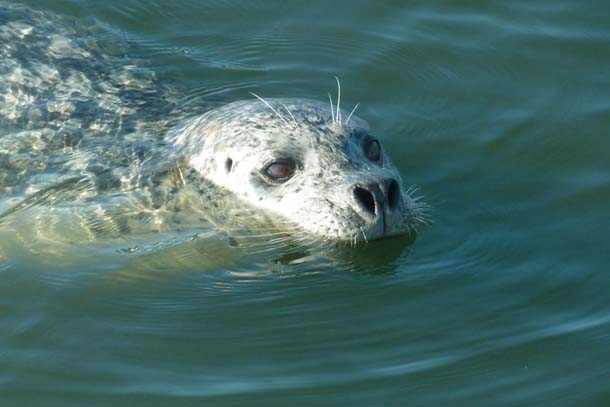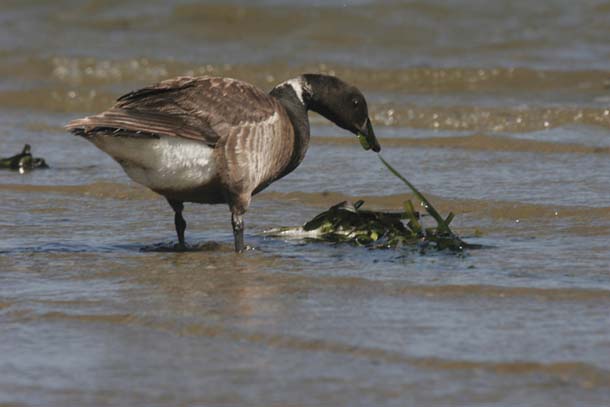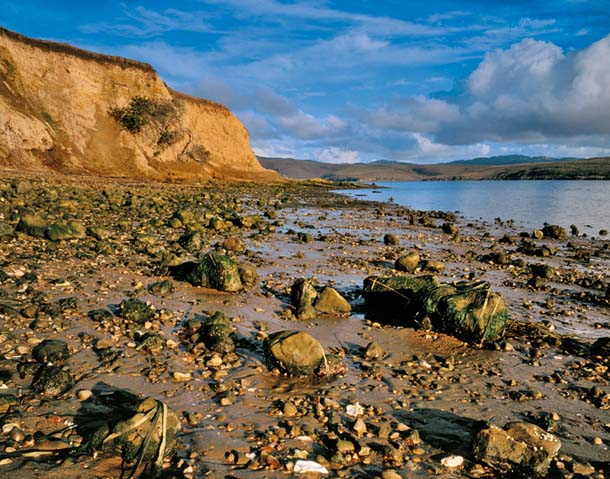Dawn. Spring tide. Fog shrouds the estuary. A shore-cast tree trunk–contorted, branching skyward–rests in the shallows. On its twisted branches roost a half-dozen cormorants, some with wings outstretched or akimbo, others standing upright, necks coiled into graceful question marks. That congregation, silhouetted by the morning light, suspended on the rising tide between the pewter sky and the mercurial bay, conjures a prehistoric diorama, a world awaiting sunlight parables.
Estuaries–wetlands where seawater mixes with freshwater and the nutrients of each commingle–are crucial ecological engines, nurseries of the sea and arteries to the land. Nature’s rhythms are amplified here, not only through the recurrent seasons, but through the daily pulse of the tide’s ebb and flow, vast respiratory systems breathing in lunar time, remaking the world on each tidal cycle.
The largest estuary complex encompassed by the Point Reyes peninsula, Drakes Estero, resembles a huge hand, irregularly outlined by nearly 25 miles of crenulated shoreline. The main lagoon, along with its five fingers–Barries Bay, Creamery Bay, Schooner Bay, Home Bay, and Limantour Estero–comprises 2,270 acres or about 3.6 square miles at high tide.
The Drakes complex is not discrete but exists within a network of coastal wetlands–San Francisco Bay, Bolinas Lagoon, Tomales Bay, Abbotts Lagoon, the esteros San Antonio and Americano, Bodega Bay–that supports as diverse an array of estuarine organisms as any habitat on the west coast of North America. Movements of migratory fish, birds, and marine mammals between the constituents of this wetland network add to the value of each, and each to the other. These coastal treasures are connected, in turn, to others distributed up and down the Pacific Coast–from Baja’s Laguna Magdalena to the estuarine systems of the Alaska coast.

Because there are no large freshwater streams feeding Drakes Estero, the name is something of a misnomer. In strictly scientific terms, it would be referred to as a “low-inflow marine lagoon” because most of the system is fed and flushed in synchrony with the daily tidal cycle, its salinities and water temperatures mirroring nearby oceanic conditions. The estero’s productivity is not fueled by the upland watershed but rather by the ocean, in the form of nutrients that arrive on incoming tides that feed the foundations of the estuary’s food pyramid–phytoplankton, benthic algae, and salt marsh vegetation.
Early summer, I sit on a boulder at Drakes Head overlooking the confluence of Limantour and Drakes esteros. The pulse of the rising tide floods the estuary with cold seawater. Flocks of waterbirds forage at the water’s edge, their voices amplified in the translucent marine air–wails of whimbrels, insistent tattles of willets, braying brant, mellow whistles of wigeon, and the nervous chirrups of small shorebirds. A squadron of brown pelicans, as silent as they are graceful, skims the breakers just offshore. Bat rays and leopard sharks glide in on the flood tide, their silhouettes visible in the shallow water as they forage across the flats. Eelgrass blades sway on a pulse of the tide. At the base of the chalky cliffs is a narrow cobbled beach where multitudes of invertebrates–brittle stars, anemones, barnacles, and shore crabs the size of silver dollars–are busily provisioning the estuary. All are making the world come into being, each in its own way.
Another day. After an early April rain the morning sky, obscured by low cloud cover, is glazed leaden gray. The low-lying fog begins to lift and the soft geometry of the surrounding landscape is slowly unveiled. The sheltering terrain–white shale cliffs, rhythmically bedded marine terraces, and rumpled hills–defines the boundaries of the estuary.

From Bull Point, I scan a vast flock of black brant, a rather small, handsome sea goose. This congregation is en route from its traditional wintering habitat in Baja to breeding grounds on the Arctic tundra. This gathering, several thousand strong, rafts on the still water near the mouth of Barries Bay, chattering among themselves, foraging on the submerged pastures of eelgrass. No other waterbird relies so heavily on a single native food plant. During the brants’ 5,000-mile journey, eelgrass fields provide their only sustenance. With its epic odyssey, the brant is perhaps the most emblematic estuarine ambassador, its life history figuratively tethering each estuary to another, an evolutionary product of the interrelatedness of these far-flung habitats. As the brant is the estuary’s emblematic waterbird, so is eelgrass its emblematic plant. Not a seaweed, but a true flowering plant, eelgrass needs sunlight and relatively clear, cool tidal water to thrive and fulfill its variety of ecological functions–creating habitat, providing shelter and spawning substrate to myriad species, and forming the basis of primary production. Eelgrass meadows are in slow but marked decline along the Pacific coast, so those in more remote, undisturbed, and nonurbanized estuaries like this take on added significance.
A harbor seal drifts by silently, no wake. Just above the waterline, those vitreous, obsidian eyes, unblinking, take it all in. Beneath the water, her highly light-sensitive retina captures the shades of gray and the shadows of movement that make up the submerged world of the estuary. Approaching eelgrass meadows, she notices a starry flounder scutter across the sandy bottom and disappear into the root tangles. Siphons of gaper clams retract as her shadow passes over. Other than the fish that hide in the eelgrass, the creatures that reside here are too small for the seal to eat, too numerous to know, but their names suggest their peculiar beauty–the hydroids Plumularia and Obelia, the skeleton shrimp Caprella, the sea hare Aplysia, the bizarre mantis-like Pycngonids (sea spiders), and myriad other denizens of the sea grass pastures.
Our harbor seal circles the perimeter of the meadow and sees large depressions in the sandy and muddy substrate, saucer-shaped pits–half a foot to a foot deep, 10 or 12 feet in diameter– excavated by the schools of bat rays that swarm the estuary in early spring and stay through summer. The rays feed mostly on bottom-dwelling invertebrates they unearth from the soft sediment–crabs, clams, sea cucumbers, polychaete worms. These depressions provide habitat that attracts flounder, sand dabs, and small sharks that forage on the invertebrates exposed by the ray’s diggings. This suits the seal just fine; she strafes several ray pits and manages to catch a starry flounder as it tries to scoot away.

The seal then returns to nurse her pup on the sandbar, which is now surrounded by a huge roosting flock of American white pelicans, immaculate in the bright sun. The Point Reyes peninsula hosts the largest concentration of harbor seals in California, about 20 percent of the mainland breeding population, with the sandbars at Drakes Estero and the beach at Double Point together producing more than half of the pups born locally. (Drakes Estero is closed to boats from March 1 through June 30 to protect the seals from human disturbance during pupping season.)
Across the inlet, the twisted root of a coyote bush protrudes from the layered sediment of the cliff face–the peregrine’s favored perch. There the male roosts, plucking a bufflehead as deliberately as a grandmother knitting her new grandchild’s first blanket. The duck’s feathers drift off on air currents, slowly rocking as they fall. A long-tailed swallow swoops in and catches a single white feather in its beak, lining for its nest. Three mule deer pick a path down the steep slope, sure-footed but cautious. A raven patrols the tide line for carrion–carcasses of bird or fish, sea life tangled in the tidal wrack and spools of dead eelgrass blades.
The cadence of the tides, the ebbs and flows, set the adagio tempo of the estuary, a celestial metronome guiding the creatures in their daily chores as each is busy renewing the world. An osprey glides by at eye level, head cocked downward as he scans the slough for jacksmelt or flounder, unconcerned by my presence, my intrusion really, into a world that will continue to come into being long after I have left.
“Crowning Glories” was produced in collaboration with: Point Reyes National Seashore Association (PRNSA) is the primary nonprofit partner of the National Park Service at Point Reyes. PRNSA mobilizes community support for resource preservation projects within the park and provides environmental education programs that help people explore, discover, and connect with the natural world (ptreyes.org). National Park Service/Point Reyes National Seashore manages and provides public access to 90,000 acres of national park lands on and around the Point Reyes peninsula (nps.gov/pore). Funding for “Crowning Glories” was provided by the Point Reyes National Seashore Association and the JiJi Foundation, which supports conservation, research, and science education on environmental issues in California and Baja California.





